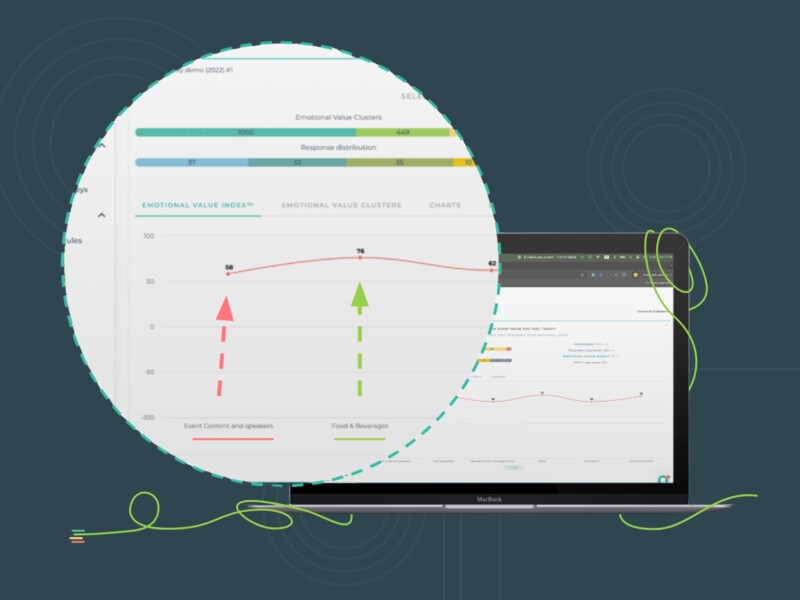While you may already know the answer to ‘What is customer sentiment?’, you would want to know its relevance in customer experience and how you can quantify customer sentiments. Let’s address it today.
What is customer sentiment?
Customer sentiments are customer emotions, opinions, or attitudes that reflect their perception of your brand. While sentiments, in general, are complex, they are an integral focal point for any brand prioritizing emotional experience. They are important because they help you understand your customers’ needs and preferences and identify their pain points when they shop for your products or services.
In our blog on customer sentiment analysis, we delve into the many benefits of customer sentiment analysis and how it can be leveraged with EVI® to gain an in-depth understanding of the many emotions customers reflect during their buying journey. Now, let’s look at the process of measuring it.
Measuring Customer Sentiments
Customer sentiment analysis is a natural language processing technique that utilizes AI or machine learning to extract insights from texts. Therefore, you need to invest in a reliable and good sentiment analysis tool. It should be able to capture the context of the feedback and provide accurate interpretations of your customer’s feelings.
- Data Collection
The first and obvious requirement is gathering customer data to interpret the underlying sentiments. When it comes to feedback, we recommend you use surveys like EVI®, C-SAT, NPS, and CES to gather structured feedback on different elements of customer experience like customer support, satisfaction, and loyalty. In addition to the questions mentioned, always include an open-ended question with an open text field that asks to explain the response selected to the close-ended question.
- Data Processing
Text processing usually breaks down the information written in the open text field, streamlines the format, and removes unnecessary filler words. Punctuation and special characters will be removed, and the entire text will be converted to lowercase for consistency.
- Text Analysis
Then, it will analyze the words to capture the context and the meaning in the best possible manner while accounting for the frequency of words. For example, if similar words recur throughout the text, they will be noted as a words with high frequency. Together, these help in weighing the words based on their importance. Think of it as the process of identifying keywords in a paragraph!
Based on the repetition of the words written, the responses can also be divided into main topics, such as delivery, product, and service. This helps to simplify analyzing the data collected, making conclusions, and taking action on data.
- Sentiment Classification
Then comes the sentiment classification. Your sentiment analysis tool will already have a predefined list of common words with connotations like positive, negative, or neutral. For example, the word ‘fabulous’ usually carries a positive connotation. Identification of such words in the text makes the analysis easier. Depending on the number of words belonging to each group, the text can be classified as positive or negative.
For sentiment classification, the intuitive AI tool may also use samples with similar phrases to categorize the text accurately. While sentiment analysis tools analyze word by word for nuanced emotions, they will also use deep learning models to understand the context of the feedback better and capture the complexity of the emotions reflected in the texts.
Sentiment can be identified and the sentiment score can be analyzed for each response, topic, or question.
- Sentiment Analysis and Scoring
Generally, the sentiment categories are positive, negative, or neutral although advanced models will be able to capture more nuanced emotions. The score given by the tool will not just tell you the category but also give an idea about the intensity of emotions reflected in the text.
Use of EVI ® with Sentiment Analysis
Despite showing the intensity, the categorization in sentiment analysis is limited to binary or multi-class models. But the actual range of positive and negative emotions is wide and varied and their impact on customer behavior and business is different.
A more holistic approach to sentiment analysis is measuring emotional experience using the Emotional Value Index (EVI®). EVI® is designed to measure emotional experience and provides detailed insights beyond simple sentiment scores.
It’s a metric designed to track and measure how customers feel at various touchpoints or different stages in the buying journey. EVI® is a special survey question that captures various emotions of customers to give you an accurate picture. While measuring emotions may sound like a complex task, EVI® actually makes it simpler.
Another benefit is that you can use it to measure individual aspects of the customer’s experience or gain an overview of the whole journey. You can send out surveys at targeted touchpoints to gather data on how customers feel. Then, the responses are clustered based on the chosen emotion. In EVI®, the emotions are categorized into different groups and each group carries a weightage depending on their impact on emotional experience. Ultimately, the score is represented as a percentage.
A higher score implies a high level of emotional experience whereas a lower score indicates a negative emotional experience. And since EVI has a high correlation with conversion rates and revenue, your EVI score actually tells if your CX level helps you grow or if it is the cause of churn. Learn more about measuring EVI here!



